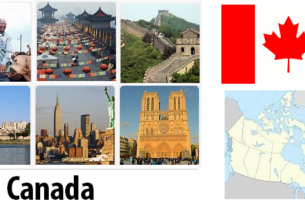Nova Scotia [ nə ʊ və skə ʊ ʃ ə], German Nova Scotia province in eastern Canada, 52,942 km 2, (2017) 953 900 residents, capital is Halifax, another major city Sydney.
The population is predominantly of British origin, with early German settlements near Lunenburg. Nova Scotia comprises the 580 km long peninsula east of the Bay of Fundy and Cape Breton Island in front of the Gulf of Saint Lawrence. The area belongs to the Appalachian Mountains, a rump mountain range (here up to 532 m above sea level) with various plateaus. About 78% of the area is forested. The maritime influenced climate is relatively mild; the ports remain ice-free.
Only valleys and the marshland on the Bay of Fundy (about 10% of the area in total) are agriculturally usable, especially animal husbandry and fodder crops, fruit growing (especially apples) in the Annapolis valley and blueberries in the northeast of the province; also timber industry (cellulose extraction and paper production) and fishing. Coal deposits on Cape Breton Island and iron ore deposits on Newfoundland Island founded the iron and steel industry near Sydney around 1900. The site is now at risk due to the abandonment of mining and the unfavorable peripheral location. There are small deposits of non-ferrous metals, including Tin. Oil and gas production off the coast of Sable Island. Manufacturing and trading locations are particularly in the port cities of Halifax and Dartmouth, however, the industrial base is weak. After the decline of the steel and mining industry, the promotion of smaller company structures began in the early 1990s, which led to an expansion of knowledge-based services (especially software development, call centers) in Halifax and Sydney. The tourism sector is also growing slightly, but is heavily dependent on the season. – The Joggins fossil site in the northwest of the province was declared a UNESCO World Heritage Site in 2008.
History: Nova Scotia was part of the French-settled Acadia, which was in dispute with England. Becoming British in 1713, it was one of the founding provinces of the Dominion of Canada in 1867.
Halifax
According to hyperrestaurant, Halifax [ Hæl ɪ fæks], is the capital and main port of the province of Nova Scotia, Canada, on a bay of the Atlantic, 297,900 residents, as Metropolitan Area 417,800 residents and is largest city in “Atlantic Canada”;catholic archbishop’s seat; five universities, conservatory, immigration museum (national museum), maritime museum, Fairview Lawn cemetery with around 150 victims of the Titanic disaster, art gallery; Military base, trading center; the traditional industries (foundries, oil refineries and chemical industry, shipbuilding, motor vehicle, food and furniture industries) employ only a few people today, but the service sector is expanding; Well-protected, ice-free harbor, international airport; cultural center of the province.
The city is dominated by the citadel (built in 1828 on foundations from 1749); today museums. Saint Paul’s Church (1750) is the oldest Anglican church in Canada; Province House (1818); Government building (1800).
Halifax was founded in 1749 by British immigrants and in the following years also took in Protestants who had emigrated from the Palatinate and the Lower Rhine. In the colonial conflicts with France and the USA as well as in the two world wars, Halifax was an important military base.
Sydney
Sydney [ s ɪ dn ɪ ], industrial and port city in the province of Nova Scotia, Canada, on the northeast coast of Cape Breton Iceland, 29 900 residents; private University College of Cape Breton (founded 1951); formerly steelworks and coal mining, today reorientation with information technology; in future more natural gas production (offshore), tourism (landing stage for cruise ships).
Founded in 1783 by loyalists from New York State and named after the British Interior and Colonial Minister Lord Thomas Townshend Sydney (* 1733, † 1800). Since 1995 Sydney has belonged to the Cape Breton Regional Municipality (106,000 residents), a large urban community.
Prince Edward Island
Prince Edward Iceland [ pr ɪ ns edwəd a ɪ lənd], an island in the south of the St. Lawrence Gulf, is the smallest and most densely populated province in Canada, 5,686 km 2, (2017) 152 000 residents, capital is Charlottetown.
The colloquial language is English (94% of the population). The island (224 km long, 4-60 km wide), separated from the mainland by the Northumberland Strait, has been connected to the mainland since June 1, 1997 by a 13 km long “Confederation Bridge”. The island surface, characterized by the Pleistocene glaciation, is predominantly flat, with an undulating interior, rising to 142 m above sea level. Economically important are arable farming (above all potatoes, predominantly high-quality seed potatoes; around 30% of Canadian production, and animal feed) and animal husbandry with milk and meat production; also fishing, especially lobster and oysters. The industry is limited to the processing of products from agriculture and fishing. Tourism on long sandy beaches (1 million guests per year) is increasing.
History: Before the arrival of the Europeans, the island was used by the Micmac Indians from the mainland as a place for fishing and hunting and for planting in the warmer seasons. It was discovered by J. Cartier in 1534, taken over by S. de Champlain for France in 1603, and recorded on his maps as Île Saint-Jean; In 1720 the first 300 French settlers arrived. The British conquered the island in 1758 and officially took possession of it in 1763. In 1799, “Saint John’s Island” was given its current name (after Edward, the fourth son of King George III of England, * 1767, † 1820). In 1873 the island became a Canadian province.


